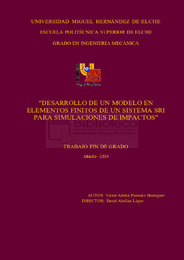Título :
Desarrollo de un modelo en elementos finitos de un sistema SRI para simulaciones de impactos |
Autor :
Pomares Berenguer, Víctor Adrián |
Tutor:
Abellan Lopez, David  |
Editor :
Universidad Miguel Hernández de Elche |
Departamento:
Departamentos de la UMH::Ingeniería Mecánica y Energía |
Fecha de publicación:
2024-02 |
URI :
https://hdl.handle.net/11000/32046 |
Resumen :
Los sistemas de retención infantil son elementos de seguridad vial que confieren protección a los menores de edad en caso de accidente. Es por ello que su uso es obligatorio, existiendo varios tipos en función del peso y rango de edad.
El sistema de retención infantil, en adelante sillita, debe estar homologado según la normativa vigente para garantizar su desempeño cuando así se requiera. En consecuencia, los fabricantes de estos sistemas deben acogerse la regulación impuesta que repercute directamente en el modelo. El Reglamento n.º 129 establece dichas prescripciones uniformes relativas a su homologación, contribuyendo a que guarden ciertas similitudes constructivas. La normativa de aplicación citada rige estos sistemas incluyendo las prescripciones uniformes relativas a la homologación de sistemas reforzados de retención infantil utilizados a bordo de vehículos. El reglamento comprende varios apartados y subapartados referentes a las condiciones que debe satisfacer un SRI para considerarse seguro.
El trabajo se centra en modelizar y analizar una sillita existente con la finalidad de adecuar un modelo fiable para futuros trabajos, así como para analizar el comportamiento durante ensayos controlados de impacto. Para ello, se parte la generación del modelo en Autodesk Inventor Professional, discretizado a continuación mediante elementos finitos en LS PREPOST y simulado finalmente en LS DYNA.
Child restraint systems are road safety elements that provide protection to minors in the event of an accident. That is why its use is mandatory, there being several types depending on weight and age range.
The child restraint system, hereinafter referred to as the seat, must be approved according to current regulations to guarantee its performance when required. Consequently, the manufacturers of these systems must comply with the imposed regulation that has a direct impact on the model. Regulation n.º 129 establishes these uniform requirements regarding their approval, helping to ensure that they maintain certain constructive similarities. The aforementioned applicable regulations govern these systems, including the uniform requirements relating to the approval of reinforced child restraint systems used on board vehicles. The regulation includes several sections and subsections referring to the conditions that a CRS must satisfy to be considered safe.
The work focuses on modeling and analyzing an existing child seat in order to adapt a reliable model for future work, as well as to analyze the behavior during controlled impact tests. To do this, the model is generated in Autodesk Inventor Professional, discretized using finite elements in LS PREPOST and finally simulated in LS DYNA.
|
Palabras clave/Materias:
seguridad vial
protección
menor de edad
accidente
homologación |
Área de conocimiento :
CDU: Ciencias aplicadas: Ingeniería. Tecnología |
Tipo de documento :
info:eu-repo/semantics/bachelorThesis |
Derechos de acceso:
info:eu-repo/semantics/openAccess
Attribution-NonCommercial-NoDerivatives 4.0 Internacional |
Aparece en las colecciones:
TFG-Ingeniería Mecánica
|
 La licencia se describe como: Atribución-NonComercial-NoDerivada 4.0 Internacional.
La licencia se describe como: Atribución-NonComercial-NoDerivada 4.0 Internacional.
.png)
